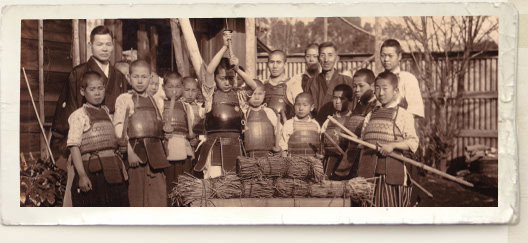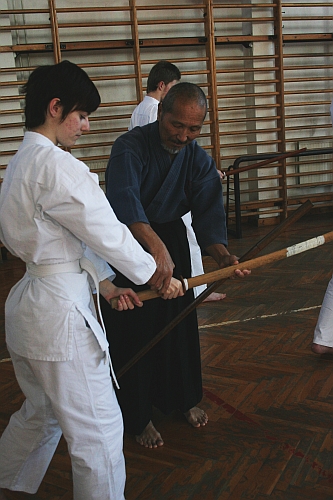
Clothing
Kenjutsu was practised in a thick kimono (keikoga) in the old times. It was needed for protection, though it was still not enough sometimes. Practises are far less dangerous nowadays, the standard clothes in kenjutsu are normal karate gi and trousers. Beginners wear white belt, intermediates wear blue and brown belts, and those who successfully completed their exam for 1st dan can wear black belt with hakama.

(László Kehidai)
What
is a hakama and who wears it?
 A
hakama is the skirt-like pants that some Ju-jitsu practicioners wear.
Traditionally, it was worn by the samurai. The standard gi worn in Karate,
Aikido and Judo classes as well as in other martial arts was usualy the
underclothes.
A
hakama is the skirt-like pants that some Ju-jitsu practicioners wear.
Traditionally, it was worn by the samurai. The standard gi worn in Karate,
Aikido and Judo classes as well as in other martial arts was usualy the
underclothes.
Originally, the hakama was worn as an outer garment
to protect a samurai horseman's legs from brush, weeds, etc. (similar
to a cowboys leather chaps). In Japan, since leather was so very hard
to come by, heavy cloth was used in its place. After the samurai made
the transition from mounted soldiers to foot soldiers, they continued
to wear the hakama largely due to the fact that it set them apart and
made them easily identifiable.
[...]Most of
the students were too poor to buy a hakama but it was required that everyone
wear one. If the student could not get one from an older relative, they
would remove the cover from an old futon, cut it, dye it, and have it
made into a hakama. Since the dyes that were used were very cheap, the
colorful pattern of the futon would start to show through the dye. Eventually,
the stuffing from the futon would start to work its way out of the material.
The Hombu dojo was a very colorful place, with all the various colors
of hakama. Traditional hakama were not just solid colors. The material
used often had patterns wowen or printed onto them.
In most Ju-Jitsu schools of today, the hakama is reserved for the yudansha
(black belt students). Few schools allow all practitioners to wear one,
while some schools allow women to start wearing it much earlier than men
(general modesty of women is the explanation, since a gi was originally
undergarments).
The hakama has 7 folds in it (5 in the front,
2 in the back) and has the following symbolic meaning:
-
Yuki – courage, valor, bravery
-
Jin – humanity, charity, benevolence
-
Gi – justice, righteousness, integrity
-
Rei – etiquette, courtesy, civility (obedience)
-
Makoto – sincerity, honesty, reality
-
Chugi – loyalty, fidelity, devotion
-
Meiyo – honor, dignity, prestige
(http://www.loyola.edu/maru/hakama.html)
